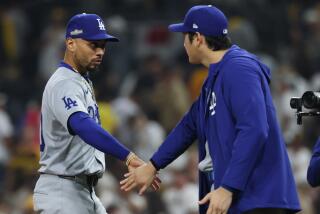Here’s Missing Persons Report
- Share via
Maybe it’s only a handful of games and not a true trend. Maybe it’s only April showers and not an accurate warning of a gathering storm.
Seventeen of the 30 major league teams, including eight that play in comparatively new ballparks, showed an attendance decrease as they entered the final weekend of the first month.
The decreases range from about 2,000 for the Chicago White Sox to about 95,000 for the Texas Rangers.
Overall attendance is down about 4%--a blip, perhaps, that will be corrected during warmer summer months. After all, it was only two years ago that baseball set an attendance record, drawing 73 million.
Maybe, however, it’s symptomatic of an increasingly skeptical and fragile fan base that can partially be measured by last year’s 200,000 falloff.
Maybe the sputtering turnstiles should represent a drumbeat to management and union labor negotiators, a warning that another work stoppage would be difficult--if not impossible--to overcome.
As Rick Burton, executive director of the University of Oregon’s Warsaw Sports Marketing Center, put it: “I just don’t think baseball can take another hit, but the message, as I read it, is that most industry executives continue to think the game is infallible, will always survive, you can’t kill it.
“I think that’s horribly flawed thinking.”
Baseball’s chief operating officer suggests Burton may be getting the wrong message.
Robert DuPuy said concern about the industry’s potential fallibility is what drives the clubs’ pursuit of an economic system that would aid competitive balance and that both sides are cognizant of the risk of another shutdown.
“There’s no question both sides recognize the devastation the last prolonged work stoppage did and are determined to avoid it if possible,” DuPuy said. “I think it’s the one thing that gives you hope we’ll make a deal.
“Both sides realize we got lucky [last time]. Who knows if we’d get that lucky again? Everybody’s scared about that. Everybody’s concerned about it.”
Lucky last time?
Lucky, he meant, in the sense that Cal Ripken’s Jr.’s pursuit of Lou Gehrig’s record for consecutive games, the New York Yankees’ return to dominance and the Mark McGwire/Sammy Sosa home run races helped lift baseball out of the ashes of the 1994-95 stoppage and--in concert with the wave of new ballparks--generated an attendance boom of 70 million plus in each of the last three years.
However, Burton said much of that rebirth has been “squandered.”
He cited soaring salaries and ticket prices, the inability to avoid negative, headline-usurping labor issues and the competitive balance mantra that has served to convince some fans in some cities, although certainly not the union, that there’s no hope.
He called it a confluence of issues over several years, and said, “Now, for the first time in a long time, there’s no new teams or new stadiums to cover the spreading problems.”
David Carter of the Los Angeles-based Sports Business Group agreed.
He said it would be a mistake for baseball to believe it holds the relevant position it once did, that “a lot of fans have simply become jaded and cynical about what the sport has to offer right now.”
In particular, he said, “Middle-aged fans who have been through a couple work stoppages and now may face another are simply fed up, and, of course, that tends to spill over to their kids and younger fans who have a lot of other options.”
Maybe all of this, the specter of doom and gloom, is a little premature.
The weather always affects attendance in April, as does the fact that schools are still in session. The struggling economy is a factor, and many fans may remain distracted by the terrorist attacks of Sept. 11.
The heat of summer, the prospect of tight races, the possibility of Barry Bonds, Sosa, Alex Rodriguez or some other player providing a spectacular individual performance, could start turnstiles spinning.
Still, there are troublesome signs. For example:
* The Pittsburgh Pirates, who led the National League Central entering the weekend, and Milwaukee Brewers, both blessed with second-year ballparks, have experienced among the largest attendance decreases.
* The Atlanta Braves have set a series of Turner Field attendance lows, and the Montreal Expos, unable to escape the shadow of contraction and the apathy of their community despite a stunning start, drew another season low--3,501--while winning their sixth consecutive game Wednesday night.
* The Cleveland Indians are down almost 75,000 at Jacobs Field, where until last year they played to only sellouts, and there are empty seats on a daily basis at the former hotbeds of Camden Yards, Coors Field and The Ballpark at Arlington.
All of this against the backdrop of another season of labor rhetoric, the possibility of a late-summer strike if the union believes owners intend to unilaterally implement new work rules when the World Series ends, and the probability that there will be no meaningful negotiations until arbitrator Shyam Das, in late June or beyond, rules on the union’s contraction grievance.
For Commissioner Bud Selig, the loss of faith and hope in too many cities plays into the attendance figures, but, he said, “You can’t make a judgment this early. Look, it’s possible amid a flattening economy we may not set an attendance record every year, but do I think we have a serious problem? No. Do I watch every day and worry about it? Yes. When you quit worrying about your customers you’re in trouble.”
Selig said he worries about it to the extent that it guides his daily thinking on the labor front. If convinced the system has to change to improve competitive balance, he understands the risk in a ninth work stoppage.
Will the risk and worry outweigh the conviction that change is needed?
That’s as unlikely as a sellout in Montreal.
More to Read
Go beyond the scoreboard
Get the latest on L.A.'s teams in the daily Sports Report newsletter.
You may occasionally receive promotional content from the Los Angeles Times.










